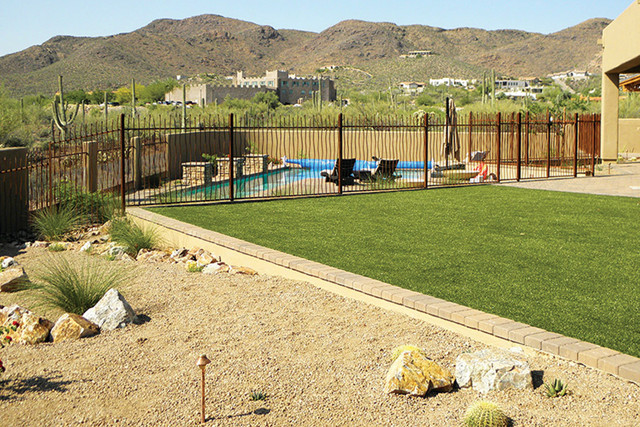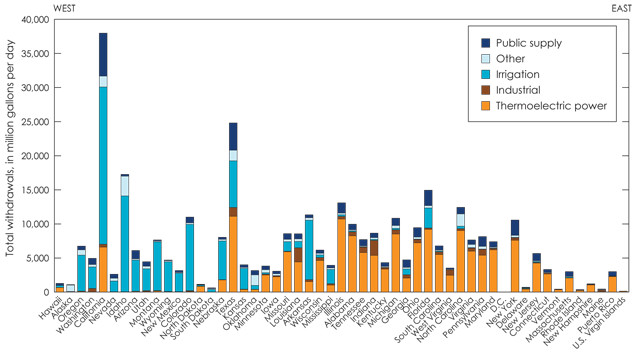
by Sara E. Pratt Friday, September 4, 2015

In 2013, the desert city of Tucson, Ariz., delivered the same amount of water to its customers as it did in 1989, when the population was roughly 30 percent lower, thanks in part to the increasing popularity of xeriscaping and smaller pools and lawns. Credit: sonorangardensinc.com/xeriscapes-tucson.
Americans are using less water today than they have at any time since 1970, according to a report by the U.S. Geological Survey (USGS), which has tracked water use since 1950 and issues reports every five years.
In 2010, about 355 billion gallons of water were withdrawn per day — from fresh and saline surface water, and fresh and saline groundwater — a 13 percent drop from 410 billion gallons per day in 2005. The reductions are attributed to successful conservation programs and improving efficiency, but the country’s changing demographics may be an important factor as well.
The largest uses of water — accounting for 94 percent of all withdrawals nationwide — were for thermoelectric power production, irrigation, the public water supply and industry. Between 2005 and 2010, consumption fell in all four categories, including, for the first time, withdrawals for public water supplies. During the same period, the country’s population increased by 4 percent.
“Even as the U.S. population continues to grow, people are learning to be more water conscious and do their part to help sustain the limited freshwater resources in the country,” said Mike Connor, deputy secretary of the U.S. Department of the Interior, in a statement.
Declines were also attributed to more efficient cooling systems at thermoelectric plants, more emphasis on efficient water use and recycling by industry, and the 2008 economic recession, which decreased industrial output, reported the USGS team led by Molly A. Maupin, a hydrologist with the USGS Water Resources Division in Boise, Idaho.
Although the news is good, the trend demands a rethink of the way we plan for future water use, which has traditionally been based on population, says Gary C. Woodard, senior water policy and economics consultant with Montgomery & Associates, a water-resources consulting firm in Tucson, Ariz.

Total water withdrawals and category of use by state and territory (from west to east), 2010. Credit: USGS.
“There is just no tie anymore between population and water demand,” Woodard says. Despite booming population growth in the Southwest, household water demand in Arizona, New Mexico, Nevada and elsewhere has been dropping for decades, Woodard says. For example, the Albuquerque Bernalillo County Water Utility Authority in New Mexico delivered the same amount of water to its customers in 2013 as it did in 1984, when the population was 70 percent lower.
The increasing popularity of municipal conservation programs, which actively encourage citizens to conserve water, is often credited with the drop in household use. However, Woodard says, other factors, including changing sociodemographics, which result in “passive conservation,” may be playing a bigger role than is recognized. Water resource planners need to take into account the “changing face of the American family and their changing tastes,” Woodard said at last year’s annual meeting of the American Institute of Professional Geologists in Prescott, Ariz.
Today, only 33 percent of family households have young children, while 45 percent of households have dogs. “Dogs are the new toddlers,” he says. In addition, many people don’t spend as much time at home as they did in the past, and the maintenance required for lawns and swimming pools is driving a trend of less turf and smaller pools — or their removal altogether.
Many new housing developments are now xeriscaped with native, water-conserving plants (although dog owners still favor some turf). Another driver of decreasing demand is the adoption of water-saving appliances. When an old appliance, such as a washing machine, dishwasher or toilet breaks down, consumers’ options to replace it tend to include only newer, more-efficient models. There is also a trend to replace old evaporative coolers, which use water and fans to cool a home, with electric air conditioning units.
Researchers modeling future consumption must pay attention to the details, Woodard says. For example, in households with children, the kids’ ages matter. “Infants don’t take showers or flush toilets,” he says. “Small children usually take baths, and teenagers shower.”
Woodard and his colleagues are developing a new water-use model that takes these changing trends into account to forecast municipal water demand; the model is now undergoing testing in Arizona.
It’s important to get the models right, as getting them wrong can be costly, Woodard says. The city of Seattle, Wash., for example, he notes, improved its infrastructure over the last decade to keep up with projections of rapidly growing demand that, ultimately, did not materialize after the 2008 housing market crash. Models now project the city will not see the predicted demand for another 45 years — just when the city’s new infrastructure will have reached the end of its useful life.
Overestimating demand has other consequences as well. Unused water can stagnate in pipes, where it warms, providing a hospitable environment for pathogens, for example. Correcting such mistakes in existing systems involves expensive fixes like installing additional pumping stations or chlorination treatment along the way.
A recent U.S. Geological Survey report on U.S. water use categorized withdrawals by state, source (ground or surface), type (freshwater or saline) and end use. Four states — California, Florida, Idaho and Texas — accounted for more than a quarter of the nation’s withdrawals.
California, gripped by an ongoing drought, was responsible for 11 percent of all withdrawals overall and 10 percent of freshwater withdrawals nationwide in 2010, mainly for irrigation and thermoelectric power.
Florida withdrew the largest amount of saline water, mainly surface water used in the production of thermoelectric power, which accounted for 18 percent of the nation’s saline withdrawals.
In Idaho, 81 percent of withdrawals were for irrigation.
Texas accounted for about 7 percent of all withdrawals, mainly for thermoelectric power, irrigation and public supply.
Oklahoma and Texas accounted for about 70 percent of the total saline groundwater withdrawals in the United States, which were mostly used for mining.
© 2008-2021. All rights reserved. Any copying, redistribution or retransmission of any of the contents of this service without the expressed written permission of the American Geosciences Institute is expressly prohibited. Click here for all copyright requests.